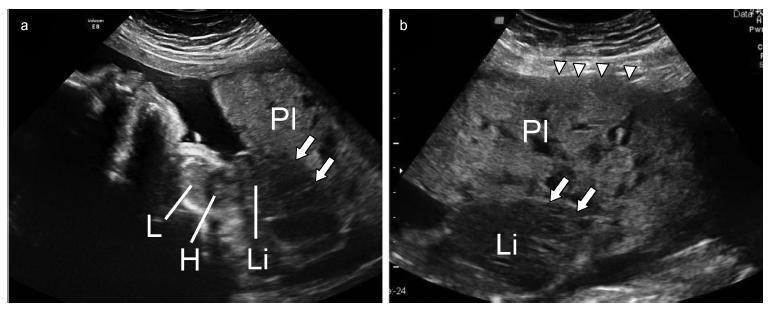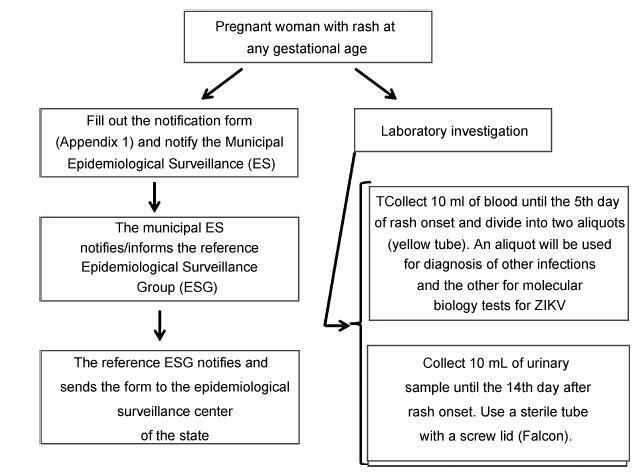You searched for:"Geraldo Duarte"
We found (52) results for your search.Summary
Rev Bras Ginecol Obstet. 2017;39(3):142-146
A case was reported of a fetus with the anomaly of limb body wall complex associated with placenta accreta. To date, only one account of this condition has been published in the world literature. Due to the low frequency of both complications, the hypothesis has been raised that this association may have happened not by mere coincidence, but rather by a possible common etiopathogenic mechanism. For the first time, a study proposes the existence of a possible etiopathogenic connection between the anomaly of limb body wall complex and hypoxic disorders caused by inadequate placentation in previous uterine scarring.

Summary
Rev Bras Ginecol Obstet. 2001;23(1):15-20
DOI 10.1590/S0100-72032001000100003
Purpose: to evaluate the seroprevalence of infection caused by HSV-2 among pregnant women delivering at the University Hospital, Faculty of Medicine of Ribeirão Preto (UHFMRP-USP) and to standardize laboratory techniques to be used for this purpose. Methods: a total of 1500 blood samples from pregnant women seen at the Obstetric Center of the Department of Gynecology and Obstetrics, UHFMRP-USP, between January 1st and October 31st, 1996, were evaluated. To determine the real prevalence of HSV-2 infection, the ELISA technique was standardized but, during its initial use, it was found to be not sufficiently specific to discriminate between the two viral types (75%). Thus, it became necessary to use a more specific technique and the method standardized for this purpose was Western blot, which can detect the specific HSV-2 viral protein. Results: the seroprevalence of herpes infection induced by the two viral types (HSV-1 and HSV-2) was 94.5% when ELISA was used. With the use of Western blot, a 32% seroprevalence of HSV-2 infection was detected in the studied population, whether symptomatic or asymptomatic. Conclusion: a high prevalence of carrier status for HSV-2 and HSV-1 infection was detected, as shown by the high rate of positivity for antibodies against this virus. ELISA did not show sufficient specificity to discriminate between HSV-2 and HSV-1 antibodies.
Summary
Rev Bras Ginecol Obstet. 2010;32(4):156-162
DOI 10.1590/S0100-72032010000400002
PURPOSE: to analyze the differential diagnosis, follow-up and therapeutic approach in five cases of primary cardiac tumors diagnosed during the prenatal period. METHODS: during the period from January 1997 to December 2008, 7989 pregnant women were submitted to morphological ultrasound due to the presence of risk factors for fetal malformations. Fetuses with hyperechogenic intracardiac masses larger than 1 mm diagnosed by ultrasound evaluation of the fetal heart, were selected for study. The differential diagnosis between the different tumor types was made on the basis of the ultrasound characteristics of the masses. RESULTS: five fetuses with hiperechogenic intracardiac masses were diagnosed, corresponding to a 0.06% prevalence rate. Gestational age ranged from 28 to 36 weeks (mean: 31), and maternal age ranged from 23 to 45 years (mean: 34,2). The most frequent location of the masses was the left ventricle (100%). Echographically, all masses were single or multiple, hyperechogenic, homogeneous and well delimited, compatible with a diagnosis of rhabomyoma. In cases in which the diameters of the masses were less than 20 mm, an expectant conduct was followed and no complications occurred during the prenatal period. One case with a huge tumor presented arrhythmia and cardiac insufficiency during the 35 gestational weeks, and the interruption of pregnancy was indicated. Tuberous sclerosis was associated in four cases (80%) and the diagnosis was confirmed during the postnatal follow-up. CONCLUSIONS: fetal morphological ultrasonography is the main form of early detection of primary cardiac tumors. The fetal cardiac evaluation is of fundamental importance for the differential morphological characterization of cardiac masses and for the evaluation of cardiac function. Rhabdomyomas are the most common type of fetal tumor. An expectant pre and postnatal conduct is followed, with a low risk of complications and with the possibility of spontaneous regression in most cases. Postnatal clinical follow-up is mandatory due to the high frequency of associated tuberous sclerosis.

Summary
Rev Bras Ginecol Obstet. 2007;29(4):171-174
Summary
Rev Bras Ginecol Obstet. 1998;20(4):193-198
DOI 10.1590/S0100-72031998000400004
The patients who do not adjust to the metabolic changes of pregnancy and those with previous alterations in carbohydrate metabolism show a significant increase in perinatal morbidity and mortality. In order to contribute to a better prenatal management of diabetic patients, the authors reviewed 60 cases of diabetes during pregnancy, assisted at the Department of Obstetrics and Gynecology, Faculty of Medicine of Ribeirão Preto, University of São Paulo. The sample was divided into two groups: one with prenatal care according to the Department protocol, and referred to this center for pregnancy resolution, and the other without appropriate prenatal care. In the group with prenatal care according to the Department protocol the complications observed were related to prematurity. The group without appropriate care showed 3 cases of congenital malformations, 3 cases of prematurity, 1 case of severe neonatal hypoglycemia, 1 case of macrossomia, 1 case of intrauterine growth retardation and 1 neonatal death. Comparing the groups, it became clear that the appropriate prenatal care is essential for the diabetic pregnant patient, but also that a reference center, such as this Obstetrical and Gynecological Department, must be fully integrated with the regional health centers, in order to offer assistance before and during gestation to the diabetic patients.
Summary
Rev Bras Ginecol Obstet. 1999;21(4):201-205
DOI 10.1590/S0100-72031999000400004
Purpose: evaluation of the risk factors [lesion grade, seropositivity for type 1 acquired immunodeficiency virus (HIV-1) and association with pregnancy ] for relapse of human papillomavirus (HPV) induced lesions of the female genital tract. Patients and Methods: seventy patients with a clinical, colposcopic and cytologic diagnosis of HPV infection were studied. Clinical follow-up lasted at least 6 months after the initial treatment, thus permitting the evaluation of the therapeutic results. Twenty-seven of these patients were pregnant and 12 were seropositive for HIV-1. The remaining 44 patients were not in the pregnancy-puerperium cycle and 14 of them were HIV-1 positive. According to cytologic criteria, the cervical lesions were classified as changes associated with HPV or grade I cervical intraepithelial neoplasia (CIN I) (low grade lesions) or CIN II/III (high grade lesions). Data were analyzed statistically by the exact Fisher test, with the level of significance set at p<0.05. The therapeutic scheme for lesions limited to the uterine cervix was cryo- or electrocautery (EC), whereas topical 5-fluorouracil was used for the diffused lesions through the vaginal wall. For the lesions in the vulvoperineal region, 80% trichloroacetic acid was used, and when they were voluminous, EC was applied. Among the pregnant women, a cryocautery was used for lesions limited to the cervix and EC for diffuse lesions. Results: among the HIV-1-negative pregnant women there was an 87.5% rate of recurrence when the lesions were in the cervix-vagina, and no recurrence when the lesions were vulvoperineal. In contrast, seropositive pregnant women presented 100% recurrence regardless of the site of the lesion. Among nonpregnant HIV negative women, 20 and 24% recurrence was observed in the cervix-vagina and in the vulvoperineal region, respectively, as opposed to 87.5 and 100% recurrence, respectively, for the same regions among HIV positive women. The lesions associated with CIN showed a higher frequency of recurrence with increasing CIN grade and a synergistic effect with the association of HIV-1 and pregnancy. Conclusions: the recurrence rate for women treated for HPV-induced lesions is high and the association with pregnancy, HIV and increased grade of the intraepithelial lesions are synergistic factors in the determination of therapeutic failure. The site of implantation of HPV-induced lesions is of prognostic significance only when the infection is not associated with HIV.
Summary
Rev Bras Ginecol Obstet. 1999;21(4):223-226
DOI 10.1590/S0100-72031999000400007
Purpose: to evaluate retrospectively the obstetrical and perinatal aspects of multiple pregnancies with the death of one fetus. Methods: a retrospective study on 26 pregnant women with multiple pregnancies and death of one twin. A conservative approach was followed and the patients were followed-up clinically with blood clotting tests. Results: in 50% of the cases fetal death occurred between 20 and 32 weeks of pregnancy. The time between death and resolution of pregnancy ranged from 6 to 148 h. Death of the other twin occurred in two cases. In 15 cases, the surviving twin had a good course, with two of them presenting slight neurological sequelae. In the other nine cases the other twin died after birth. No pregnant woman developed coagulation disorders.
Summary
Rev Bras Ginecol Obstet. 2017;39(5):235-248
From the discovery of the Zika virus (ZIKV) in 1947 in Uganda (Africa), until its arrival in South America, it was not known that it would affect human reproductive life so severely. Today, damagetothe central nervous system is known to be multiple, and microcephaly is considered the tip of the iceberg. Microcephaly actually represents the epilogue of this infection’s devastating process on the central nervous system of embryos and fetuses. As a result of central nervous system aggression by the ZIKV, this infection brings the possibility of arthrogryposis, dysphagia, deafness and visual impairment. All of these changes of varying severity directly or indirectly compromise the future life of these children, and are already considered a congenital syndrome linked to the ZIKV. Diagnosis is one of the main difficulties in the approach of this infection. Considering the clinical part, it has manifestations common to infections by the dengue virus and the chikungunya fever, varying only in subjective intensities. The most frequent clinical variables are rash, febrile state, non-purulent conjunctivitis and arthralgia, among others. In terms of laboratory resources, there are also limitations to the subsidiary diagnosis. Molecular biology tests are based on polymerase chain reaction (PCR)with reverse transcriptase (RT) action, since the ZIKV is a ribonucleic acid (RNA) virus. The RT-PCR shows serum or plasma positivity for a short period of time, no more than five days after the onset of the signs and symptoms. The ZIKVurine test is positive for a longer period, up to 14 days. There are still no reliable techniques for the serological diagnosis of this infection. If there are no complications (meningoencephalitis or Guillain-Barré syndrome), further examination is unnecessary to assess systemic impairment. However, evidence is needed to rule out other infections that also cause rashes, such as dengue, chikungunya, syphilis, toxoplasmosis, cytomegalovirus, rubella, and herpes. There is no specific antiviral therapy against ZIKV, and the therapeutic approach to infected pregnant women is limited to the use of antipyretics and analgesics. Anti-inflammatory drugs should be avoided until the diagnosis of dengue is discarded. There is no need to modify the schedule of prenatal visits for pregnant women infected by ZIKV, but it is necessary to guarantee three ultrasound examinations during pregnancy for low-risk pregnancies, and monthly for pregnant women with confirmed ZIKV infection. Vaginal delivery and natural breastfeeding are advised.
